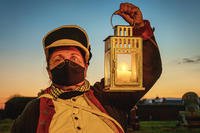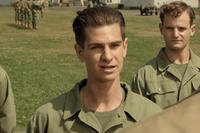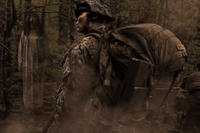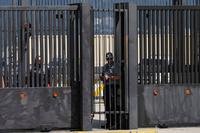We may not fly our unit flags into battle these days, but the unit guidon is still an important military tradition. Atop those flags are battle streamers, also known as campaign streamers, long, distinctively colored ribbons bearing the names of battles or campaigns in which a unit participated.
There's nothing controversial about streamers noting the names of storied places from the past 200-plus years of American conflicts. These are places like Guadalcanal and Chateau-Thierry, or campaigns like Operation Iraqi Freedom. The conflict that does attract attention is the most uniquely American one: the Civil War.
A number of U.S. military units in operation today date back to the days of the Civil War -- and 48 of them were not on the winning side. Still, they were in storied battles and today carry the appropriate battle streamer, which is colored gray to indicate they were part of the Confederate Army.
The Naming Commission, a panel of current and former military leaders tasked with reviewing and eliminating the legacy of the Confederacy in the U.S. military, has found 457 Confederate battle streamers atop unit guidons and is recommending they be removed.
The seven Civil War battles that follow is not an exhaustive list; 48 units flying 457 streamers across 12 states, three of those states that remained in the Union, are bound to have fought in more campaigns, battles and skirmishes than those listed here. These are just a few of the most important.
1. First Battle of Bull Run
Also known as the First Manassas (if you're a Confederate), the First Battle of Bull Run was fought just 30 miles from Washington and was the first major battle of the Civil War. The Union, both its military leaders and civilian population, were so unprepared for the ferocity of the Civil War that civilians actually came out to picnic and watch the battle, thinking it would be an easy win for the Federal troops.
The Union Army was just as disorganized as the Confederates, but the rebels were able to capture two Union guns; the course of the battle changed. The southern army fired within close range and charged with the rebel yell for the first time. The Union broke and ran -- even through the picnics.

2. Peninsula Campaign
By 1862, the Union needed a big win, so Gen. George B. McClellan decided to shoot for the moon. He landed a Federal army on the shores of the Virginia Peninsula to march his way to the Confederate capital of Richmond from an unexpected front.
As the Union forces approached the capital, they were caught off guard by numerous unexpected Confederate defenses and attacks. Before entering Richmond, Confederate Gen. Joseph E. Johnston's cavalry surprised McClellan, inflicting heavy casualties. Johnston was wounded and replaced by Robert E. Lee, who went on the offensive and fought the Union off.

3. Shenandoah Valley Campaign
While McClellan made his way toward Richmond, Confederate Gen. Thomas J. "Stonewall" Jackson was on the move farther west, in Virginia's Shenandoah Valley. Jackson's maneuvers in the valley not only routed four Union generals, but it also kept them from reinforcing McClellan in the Peninsula Campaign.
After nearly four months booting the Union Army around Virginia, Jackson moved his army toward the Peninsula Campaign, backing up Lee's offensive at Seven Pines to keep McClellan from capturing Richmond.

4. Battle of Gettysburg
If there's a battle on this list that needs no introduction, it's the Battle of Gettysburg. Long considered the major turning point in the Civil War, the Union's victory in the three-day battle not only ended Lee's hopes of invading the north, it gave President Abraham Lincoln a needed follow-up victory to the Battle of Antietam and the Emancipation Proclamation.

Gettysburg was the deadliest battle of the Civil War, wounding and killing around 50,000 troops. It also dashed a rebel plan to force Lincoln into a peace negotiation while Lee's army marched on Washington from the north.
5. Battle of Cold Harbor
By 1864, McClellan was out as the Union Army's commander and Lt. Gen. Ulysses S. Grant was in. Grant went after Lee's Army of Northern Virginia by moving his own Army of the Potomac between Lee and the Confederate capital in the Overland Campaign.

Lee was aggressive and constantly moved to block Grant from his goal, but rather than leave the area as his predecessors had, Grant stuck to his plan. His final battle came at Cold Harbor, where Grant assaulted heavily fortified Confederate lines, betting that the defenders were exhausted. He was wrong. The Union Army suffered more than 10,000 killed and wounded there.
6. Siege of Petersburg
Grant may have lost many of the battles of the Overland Campaign, but it was a strategic victory for the Union. The Army of the Potomac followed up by laying siege to Petersburg, Virginia, just 30 miles from Richmond. For almost 10 months, the Union dug and fought among miles of trench lines between the two cities.

Petersburg was a crucial target for the Union. If captured, Grant could cut Lee's army off from its supply lines and threaten Richmond -- which is exactly what happened. Grant launched a massive offensive on April 2, 1865, that forced Lee to abandon both cities.
7. Battle of Appomattox Court House
On the run after abandoning Richmond and Petersburg, Lee's army was making its way to North Carolina in an attempt to link up with Gen. Joseph E. Johnston's Army of Tennessee. He never made it. Union Gen. Philip Sheridan's cavalry was hot on his tails. Lee decided to turn and fight him.
It was a mistake. Lee believed Sheridan's light cavalry was the only force in the area, but there were two corps of infantry following the Union cavalry. Outnumbered by the Union nearly three to one and his avenue of escape cut off, Lee was forced to surrender the Army of Northern Virginia, effectively ending the Civil War.

-- Blake Stilwell can be reached at blake.stilwell@military.com. He can also be found on Twitter @blakestilwell or on Facebook.
Want to Learn More About Military Life?
Whether you're thinking of joining the military, looking for post-military careers or keeping up with military life and benefits, Military.com has you covered. Subscribe to Military.com to have military news, updates and resources delivered directly to your inbox.
















